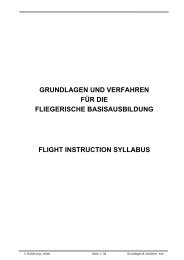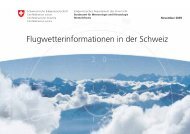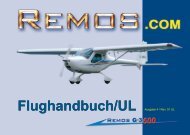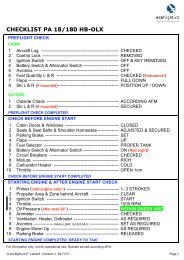Pilot Operating Handbook - Ecoflight.ch
Pilot Operating Handbook - Ecoflight.ch
Pilot Operating Handbook - Ecoflight.ch
Create successful ePaper yourself
Turn your PDF publications into a flip-book with our unique Google optimized e-Paper software.
Rev. 01 – January 7 th , 2008<br />
10.1 Flight Training Supplement<br />
2 Take-Off<br />
Take-off under normal conditions<br />
1. After the pre-flight <strong>ch</strong>eck has been carried out, extend flaps<br />
to 15° position.<br />
2. Ensure that the elevator trim is in correct position.<br />
3. Whenever possible, take-off directly into wind. The maximum<br />
crosswind limitation for take-off is 17 mph (15 kts)<br />
demonstrated.<br />
4. Smoothly apply full throttle (fully forward) and maintain<br />
runway heading.<br />
5. As the aircraft accelerates, gently pull back on the control<br />
stick to elevate the nose slightly until the aircraft becomes<br />
airborne.<br />
6. Once airborne, slowly release the back pressure on the<br />
control stick to allow the airspeed to increase to 70 mph (60<br />
kts) at least. Maintain this speed and avoid making any<br />
climbing turns until a sufficiently safe altitude has been<br />
rea<strong>ch</strong>ed.<br />
7. When all obstacles have been cleared, retract the flaps (0°<br />
position)<br />
Take-off at tailwind conditions<br />
Similar to normal take-off except an extended take-off distance.<br />
Take-Off in rain or with dirty aircraft<br />
Surface conditions, high density altitude and temperatures, raindrops<br />
and bugs affect the performance of an aircraft. Be aware that in<br />
these conditions the performance figures are not met anymore as<br />
they apply for a clean aircraft. Expect a significant performance.<br />
Flight Training Supplement 10.1 - 3










